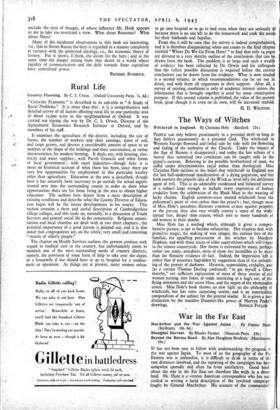Rural Life
Country Planning. By C. S. Crwin. (Oxford University Press. 7s. 6d.)
" COUNTRY PLANNING " is described in its sub-title as " A Study of Rural Problems." It is more than this : it is a comprehensive and detailed survey of all factors affecting rural life in one particular area of about I5,000 acres in the neighbourhood of Oxford. It was carried out during the war by Dr. C. S. Orwin, Director of the Agricultural Economics Research Institute at Oxford, and by members of his staff.
It examines the agriculture of the district, including the size of farms, the number of workers and their earnings, types of soil, and crops grown, and devotes a considerable amount of space to an analysis of the shape of the holdings and their convenience, or rather inconvenience, for modern farming. It deals, too, with housing, elec- tricity and water supplies ; with Parish Councils and other forms of local government ; with rural industries—though here it is more an historical account of what there has been, since there are very few opportunities for employment in this particular locality other than agriculture. Education in the area is described, though here it has naturally been necessary to go outside the actual experi- mental area into the surrounding county in order to show what opportunities there are for those living in the area to obtain higher education The authors here depart from a mere description of existing conditions and describe what the County Director of Educa- tion hopes will be the future developments in his Bounty. This section contains a short and useful description of Cambridgeshire village colleges, and this leads on, naturally, to a discussion of Youth Services and general social life in the community. Religious organi- sations and local charities are dealt with in two short chapters ; the potential importance of a good parson is pointed out, and it is also noted that congregations are, on the whole, very small and consisting " mainly of elderly people."
The chapter on Health Services outlines the present position with regard to medical care in the country, but unfortunately omits to mention one of the most outstanding needs of country districts, namely, the provision of some form of help to take over the duties of a housewife if she should have to go to hospital for a confine- ment or operation. As things are at present, many women refuse to go into hospital or to go to bed even when they are seriously dl because there is no one left to do the housework and cook the meals for their husbands and families.
From this it will be seen that the survey is indeed comprehensive, and it is therefore disappointing when one comes to the final chapter entitled " Where Do We Go From Here? " to find that only 14 pages are devoted to a very sketchy outline of the conclusions that can be drawn from the book. The problem is so large and such a wealth of evidence has been collected by Dr. Orwin and his colleagues that the fullest possible discussion is required before the correct conclusions can be drawn from the evidence. What is now needed is a second volume, in which recommendations can be set out in detail, and with them all arguments in their support. After all, a survey of existing conditions is only of academic interest unless the information that is brought together is used for some constructive purpose. If this second volume is published, the value of the present book, great though it is even on its own, will be increased tenfold.
H. D. WALSTON.


























 Previous page
Previous page